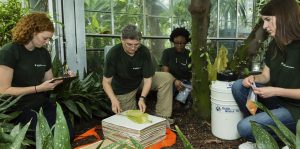This project involves conducting a detailed biodiversity assessment to be used for the development and implementation of a natural resource management plan for the 33 acres of undeveloped land included in the 147-acre campus of All Saints’ Episcopal School (ASES) in Fort Worth, Texas. The property also includes a 12-acre natural area with a wetland, riparian area, native grassland, orchard, and vegetable garden. This area is used as an outdoor classroom and is an integral part of the school’s RANGE (Research, Adventure, Nature, Geology, and Ecology) Program. If the 33 acres which have been leased in the past for grazing are to be restored for the benefit of wildlife, then that area needs to be revegetated and completely deferred from livestock grazing to allow re-establishment of native vegetation.
A BRIT team led by Resident Research Associate Dan Caudle and Research Intern Kelly Carroll (Trinity University) and advised by Dr. Brooke Best is partnering with an ASES team led by Becky Grimmer to document the plant diversity of the site and create a resource plan. The initial research focus of Summer 2018 is assessing a wooded natural drainage area that is within a utility easement related to a future sanitary sewer line to serve a neighboring development project.
Summer 2018 Assessment
A Checklist of the Flora of All Saints’ Episcopal School, Fort Worth
Authors: Kelly R. Carroll, M. Brooke Byerley, Dan Caudle, & Becky Grimmer (2018); Roger W. Sanders & Robert O’Kennon (1998)
Abstract: This checklist represents a combination of a 1998 survey of the All Saints’ Episcopal School campus’ footprint and a summer 2018 vegetative survey and voucher collection project by the Botanical Research Institute of Texas. Not all included species are vouchered, and some may no longer be present. Some may still be present but in areas unsurveyed in 2018. Sanders’ 1998 survey covered only the area now developed into All Saints’ campus (see Figure 1 in Sanders 1998 for exact boundaries), while the 2018 survey by Carroll et al. covered the land bounded by Normandale St. and the I-20 frontage road to the north & south and the Game On Sports Complex (2600 Alemeda St) and the All Saints’ campus boundary to the east & west.
References: Sanders, R.W. 1998. Natural Area Use: All Saints’ Episcopal School New Campus, Fort Worth, Texas. Technical Report, Botanical Research Institute of Texas, Fort Worth, TX.
Notes: Additional voucher collection & specimen ID by Isabella Logan, Isabella Wu, Lani R. Dufresne, Joe Lippert, Ashley Bordelon, Tiana F. Rehman, & Kim Taylor.
Fall/Winter 2018 Assessment
Research participants: Camille Carey, Jessica Lane
Report of findings forthcoming…
Summer 2019 Assessment
Research participants: Edward Bickett
Report of findings forthcoming…
Other Research Products and Resources
Maps
- Carroll, K. 2018. All Saints’ Vegetation Survey. A map showing transect and collection locations as well as notable plants and populations that might be impacted by the utility easement.
- Carroll, K. 2018. Vegetation Survey: Area of interest. A map showing in greater detail than the one above the area of interest near the utility easement that contains high value species such as big bluestem (Andropogon gerardi), yellow indiangrass (Sorghastrum nutans), little bluestem (Schizachyrium scoparium), and American elm (Ulmus americana).
- Carroll, K. 2018. Survey Area Overview. A map showing the portions of the property surveyed in Summer 2018 (by BRIT and All Saints’ Episcopal School) and in 1998 by Roger Sanders.
- Bickett, E. 2019. All Saints’ 2019 Vegetation Survey. A map showing previous transects and new transects, as well as areas of interest, soil sample sites, and demonstration plots.
Presentations
- Carroll, K. 2018. “2018 BRIT Vegetation Survey.” BRIT Research Internship presentation. Aug 2018. — An oral presentation by Kelly to the BRIT Research Department summarizing 2018 summer assessment results. Annotated pdf (slides plus notes).
- Carroll, K., D. Caudle, B. Best. 2018. Vegetation Survey of Local Urban Area Begins Long-term Documentation of Land Use Impacts on Area Biodiversity. Poster presentation for the Texas Plant Conservation Conference, 19-21 Sep 2018, Botanical Research Institute of Texas, Fort Worth, Texas, USA. — Kelly’s abstract will appear in the published conference proceedings, which will be linked here once available.
- Bickett, E., B. Best, D. Caudle. 2019. Summer All Saints’ Vegetation Survey. BRIT Research Internship presentation. 06 Aug 2019. — An oral presentation to the public summarizing 2019 project results. Annotated pdf (slides plus notes).
Blogs
- Carroll, K. Aug 2018. A Summer Deep in the Weeds: Surprises Found Along the Way. Phytophilia: Blog of the Botanical Research Institute of Texas. Read about Kelly’s summer field experience in their own words.
- Bickett, E. Sep 2019. Saga of the Texas Prairie. Phytophilia: Blog of the Botanical Research Institute of Texas. Read about Edward’s summer field experience in his own words.







